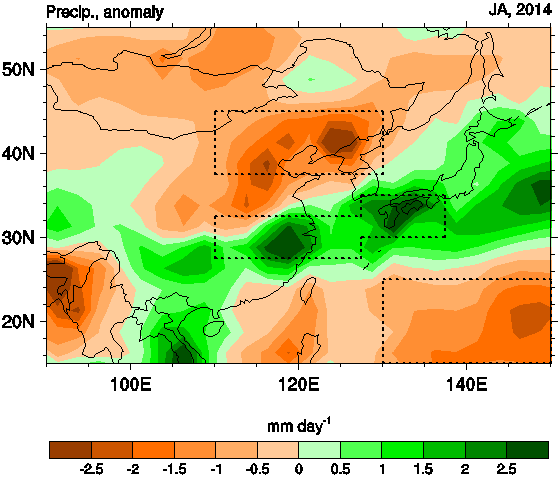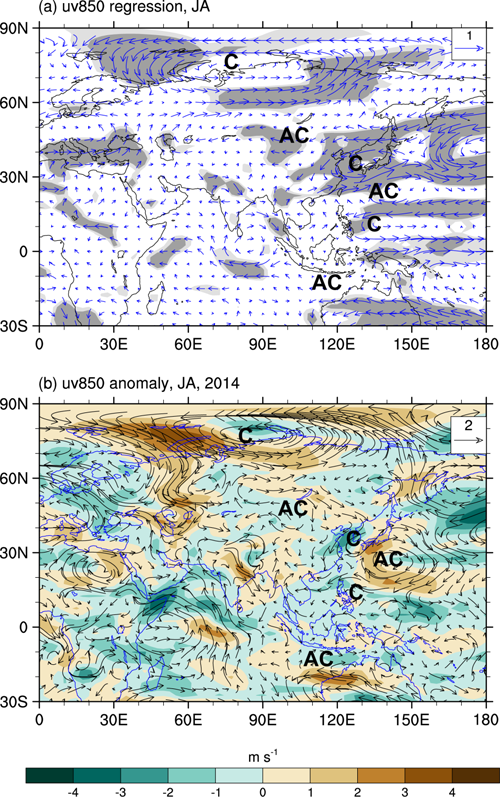Percentile of summer (June-August) precipitation anomalies in 2014 over China.(source: National Climate Center)
Prof. WANG Huijun and Dr. HE Shengping (Nansen-Zhu International Research Centre, Institute of Atmospheric Physics, Chinese Academy of Sciences) investigated the atmospheric circulation anomalies, as well as the forcing of the sea surface temperature (SST) and Arctic Ocean sea ice responsible for the severe drought in July and August 2014. They found that the East Asian summer precipitation in 2014 exhibited a tripole anomaly, with severe negative anomalies in north China, strong positive anomalies in South China, South Korea and Japan, and intense negative anomalies in the western North Pacific (Fig. 2). Along with the severe tripole precipitation anomalies, there were strong intensities of the Silk Road pattern, the Pacific–Japan pattern and the Eurasian teleconnection pattern (Fig. 3), which were responsible for the strong precipitation anomaly in 2014 through changes to the western Pacific subtropical high (WPSH) and the East Asian trough.

Figure 2 Precipitation anomaly (unit: mm day-1) during JA 2014, provided by the NOAA (http://www.esrl.noaa.gov/psd/).

Figure 3 (a) Regression maps of summer 850 hPa wind (units: m s−1) anomalies associated with tripole precipitation anomalies pattern over East Asia-Western Pacific region (as revealed by Fig. 1) during 1979–2014. Light and dark shaded regions indicate the values are significant at the 90% and 95% confidence level, based on the Student’s t-test. (b) 850 hPa wind anomaly (vectors) of JA 2014. The color shading indicates the anomalous magnitude of wind. AC and C indicate the anomalous anticyclone and cyclone, respectively. (Wang and He, 2015)
"Further analysis indicated that the SST in the North Pacific was nearly the warmest in the past 60 years and, together with the strong SST warming in the warm pool region, thus caused the strong Pacific–Japan teleconnection pattern, southward positioning of the WPSH and weakened East Asian summer monsoon.” Says Prof. WANG, “Additionally, the summertime sea ice cover in the Arctic Ocean triggered a strong Eurasian teleconnection pattern. Furthermore, the intense warming over the European continent and Caspian Sea favored the Silk Road pattern. Therefore, the severe drought over north China was the joint result of Pacific SST anomalies, Arctic sea ice anomalies, and warming over the European continent and Caspian Sea. One or two of these factors alone may not have resulted in such a severe drought.”
Their studies suggested that seasonal prediction of East Asia summer precipitation should consider not only the tropical Pacific SST, as is sometimes the case operationally, but also the North Pacific SST, the Arctic sea ice extent, and the thermal state in the Caspian Sea.
The study was published in September 2015 in Journal of Climate.
Reference:
Wang Huijun and Shengping He, 2015: The North China/Northeastern Asia Severe Summer Drought in 2014. J. Climate, 28, 6667–6681. Doi:10.1175/JCLI-D-15-0202.1
http://journals.ametsoc.org/doi/full/10.1175/JCLI-D-15-0202.1
Contact: Dr. HE Shengping,








